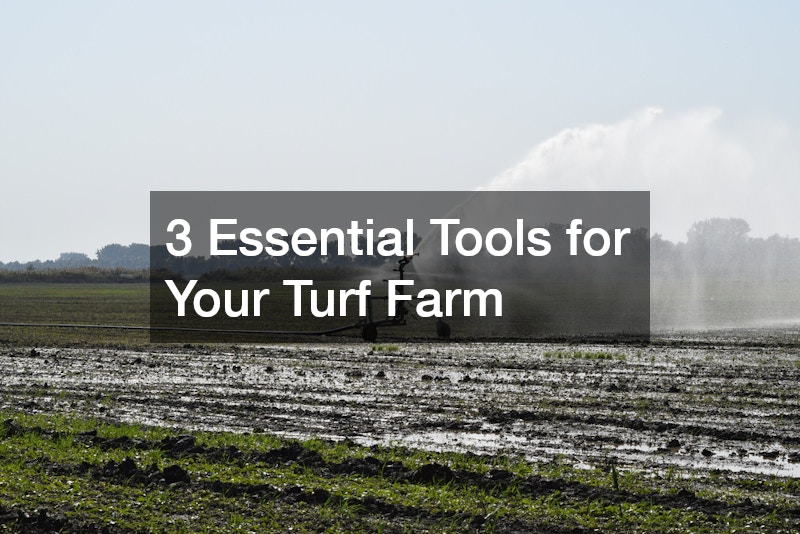
Establishing and maintaining a successful turf farm requires more than just good weather and fertile soil. It demands precision, care and the right tools to achieve consistent results.
Whether you’re just starting out or looking to optimise your operations, investing in the right equipment can make all the difference. In this article, we explore three essential tools that no turf farm should be without, helping you grow healthier, more resilient grass while maximising efficiency and productivity.
1. Soil Preparation Equipment
Before any grass can grow, the soil must be properly prepared. This stage sets the foundation for strong root systems and even turf growth. Among the most important tools in this phase are rotary hoes and power harrows. These machines are designed to break up compacted soil, mix in organic matter and level the surface to create an ideal seedbed.
Rotary hoes work by using rotating blades to loosen and aerate the soil. They are particularly effective at incorporating compost or fertilisers into the top layer, improving soil structure and nutrient availability. Power harrows, on the other hand, use vertical tines to cultivate the soil without inverting it, preserving the soil profile while providing a fine, even finish. This is especially beneficial for the farms, where uniformity is key.
Laser levelling equipment is another critical component of soil preparation. Uneven surfaces can lead to water pooling or runoff, which may result in patchy grass or soil erosion. By using laser-guided systems, farmers can achieve perfect grades across their fields, improving irrigation efficiency and ensuring that every square metre of the farm receives equal treatment. This attention to detail early on lays the groundwork for a thriving crop of turf.
2. Automatic Irrigation Systems
Water is a vital resource for any turf farm, and efficient irrigation can significantly reduce labour and water usage while promoting optimal growth. Traditional methods, such as hose reels or manual sprinklers, can be time-consuming and inconsistent. Modern automatic irrigation systems offer precise control over water distribution, enabling farmers to maintain ideal moisture levels with minimal effort.
Centre pivot and lateral move systems are commonly used in larger turf operations, providing wide coverage and consistent application. These systems are often equipped with sensors and timers that can be programmed to adjust watering schedules based on weather conditions, soil moisture levels and crop requirements. This not only conserves water but also reduces the risk of overwatering, which can lead to fungal diseases or root damage.
For smaller areas or specialty turf varieties, drip irrigation may be more appropriate. This method delivers water directly to the root zone, minimising evaporation and runoff. It is especially effective in sandy soils where water tends to drain quickly. Automated control panels and mobile apps now allow farmers to monitor and adjust irrigation remotely, offering greater flexibility and real-time insights into water usage.
3. Turf Harvesters
Once the turf reaches maturity, harvesting becomes the focus. Turf harvesters are specialised machines that cut, roll and stack turf with speed and precision. Choosing the right harvester can have a significant impact on product quality and labour efficiency.
There are two main types of turf harvesters: manual assist and fully automatic. Manual assist harvesters require an operator to guide and stack the turf, while automatic models perform the entire process with minimal human intervention. For larger operations, automatic harvesters can increase output and reduce labour costs, making them a worthwhile investment.
Key features to consider in a turf harvester include cutting accuracy, roll consistency and stacking ability. Machines equipped with GPS guidance or laser-cutting systems offer superior precision, reducing waste and ensuring uniform rolls. Reliable stacking mechanisms also protect the turf during transport, maintaining its integrity from field to customer.
Some modern turf harvesters come with integrated conveyors and wrapping systems, which streamline the loading process and improve storage. These innovations reduce handling time and help maintain the freshness of the turf during delivery. When selecting a harvester, it’s important to consider not only the scale of your farm but also the types of turf you produce and your delivery timelines.
Operating a turf farm involves a complex balance of soil management, irrigation and harvesting. By investing in high-quality tools for each of these critical stages, farmers can improve productivity, enhance turf quality and reduce operational stress. Soil preparation equipment lays the groundwork for strong growth, automatic irrigation systems maintain ideal conditions, and advanced turf harvesters ensure a professional finish. With these three essential tools, your farm will be well-positioned for long-term success and sustainability.


